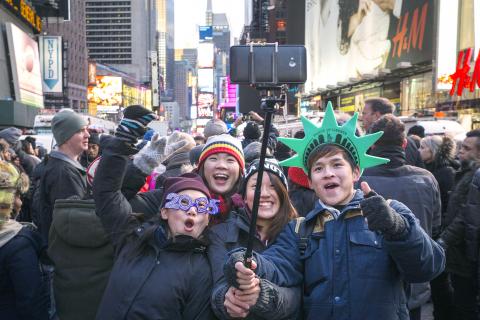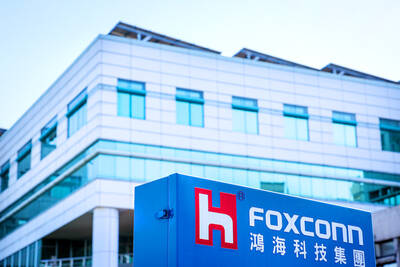Oxford Dictionaries made “selfie” the word of the year in 2013. US consumers responded by making the selfie stick the gift of the year in 2014.
Around the US this holiday season, camera shops, department stores and pharmacies have been having a hard time keeping up with demand for the selfie stick, a retractable pole that people clamp onto their smartphones to take better pictures of themselves.
Nordstrom Inc, which carried the Selfie On A Stick model in 118 stores starting in late November, said it had to reorder the item twice before Christmas and still sold out. ProMaster, which supplies camera accessories to 500 US stores, said it had to keep reordering selfie sticks after running out of stock. On Christmas day, the hashtag #selfiestick dominated Twitter, as gift-receivers posted pictures of themselves with the gadgets, which typically sell for between US$10 and US$30.

Photo: Reuters
“We basically couldn’t keep them in stock,” said Jirair Christianian, owner of Mike’s Camera, a 12-store chain based in Boulder, Colorado. “People are taking a lot of selfies these days. The selfie stick makes it easy and makes it fun.”
The holiday craze adds to evidence that selfies — photos taken of oneself and shared on social media sites like Facebook Inc’s Instagram — have gone mainstream, even with a lingering stigma that the practice is best left to reality TV stars like Kim Kardashian.
In April, US President Barack Obama endorsed selfies by snapping one of himself and US Vice President Joe Biden in the back of a limo while traveling in Pennsylvania.
Hundreds of thousands of selfie sticks have likely sold in the US since last summer, including about 100,000 last month alone, though there is no official tally since the products are so new to market, said Andy Brennan, an analyst at researcher IBISWorld.
The items became popular in camera shops over the summer and demand intensified around Thanksgiving after Time magazine named the selfie stick one of the best inventions of the year.
“It was one of the most popular Christmas gifts this year,” Brennan said, adding that drugstores including Walgreen Co’s Duane Reade had trouble stocking the gadgets. “Every retailer I spoke with about selfie sticks sold out and had to resupply.”
One of those who grabbed a selfie stick for the holidays was Caroline DiMauro, who was in line at a Walgreen store just a few days before Christmas in Cincinnati when she picked up the gift at the last minute.
“I was ecstatic when I saw it,” DiMauro said. “I had just overheard my daughter talking about how it was one of the latest hot gadgets.”
Various manufacturers make selfie sticks, which are technically called extendable monopods.
Some of the products include Bluetooth remotes that trigger the camera. Others require the user to set a timer on their smartphone to take the shot. Many of the sticks can unfold as long as about 1.2m.
The technology has raised some eyebrows. Concerned that Bluetooth remotes on selfie sticks could interfere with other devices, South Korea’s Ministry of Science banned the sale of unregulated selfie sticks in November, threatening fines and imprisonment for those breaking the law.
The popularity of the devices throws some camera stores — which are experiencing declining sales of point-and-click digital cameras as people increasingly use smartphones to snap pictures — a lifeline of sorts. With selfie sticks, camera shops can offset lost sales by selling accessories to the growing ranks of smartphone photographers.
“The smartphone has helped introduce photography to a whole lot of people who may not have been exposed to it,” said Richard Bright, director of sales at ProMaster in Fairfield, Connecticut, which offers the ProMaster Selfie Stick. “Camera shops are certainly embracing the rise of the smartphone. They’d be foolish not to.”
Selfie sticks are more than for just vanity shots of oneself. Photographers can use the pole to extend their reach, getting more friends and family members in a shot or including more sights in the background. Beyond selfies, the stick can help people get interesting camera angles or be used as a microphone boom arm.
“It’s not just about shooting your eight closest friends at arm’s length,” said Mike Worswick, owner of Wolfe’s Camera in Topeka, Kansas, who added that selfie sticks were the best-selling device this month. “It has some useful applications that go beyond the obvious.”
DiMauro ended up giving the selfie stick she bought at Walgreen to her 13-year-old daughter, Isabella.
Isabella said she plans to use the gadget to make YouTube videos with her brother Sam, 11, and sister Francie, 8.
“I’ve seen them on the Internet, so it’s kind of cool to have it now,” she said.

Hon Hai Precision Industry Co (鴻海精密) yesterday said that its research institute has launched its first advanced artificial intelligence (AI) large language model (LLM) using traditional Chinese, with technology assistance from Nvidia Corp. Hon Hai, also known as Foxconn Technology Group (富士康科技集團), said the LLM, FoxBrain, is expected to improve its data analysis capabilities for smart manufacturing, and electric vehicle and smart city development. An LLM is a type of AI trained on vast amounts of text data and uses deep learning techniques, particularly neural networks, to process and generate language. They are essential for building and improving AI-powered servers. Nvidia provided assistance

DOMESTIC SUPPLY: The probe comes as Donald Trump has called for the repeal of the US$52.7 billion CHIPS and Science Act, which the US Congress passed in 2022 The Office of the US Trade Representative is to hold a hearing tomorrow into older Chinese-made “legacy” semiconductors that could heap more US tariffs on chips from China that power everyday goods from cars to washing machines to telecoms equipment. The probe, which began during former US president Joe Biden’s tenure in December last year, aims to protect US and other semiconductor producers from China’s massive state-driven buildup of domestic chip supply. A 50 percent US tariff on Chinese semiconductors began on Jan. 1. Legacy chips use older manufacturing processes introduced more than a decade ago and are often far simpler than

STILL HOPEFUL: Delayed payment of NT$5.35 billion from an Indian server client sent its earnings plunging last year, but the firm expects a gradual pickup ahead Asustek Computer Inc (華碩), the world’s No. 5 PC vendor, yesterday reported an 87 percent slump in net profit for last year, dragged by a massive overdue payment from an Indian cloud service provider. The Indian customer has delayed payment totaling NT$5.35 billion (US$162.7 million), Asustek chief financial officer Nick Wu (吳長榮) told an online earnings conference. Asustek shipped servers to India between April and June last year. The customer told Asustek that it is launching multiple fundraising projects and expected to repay the debt in the short term, Wu said. The Indian customer accounted for less than 10 percent to Asustek’s

Gasoline and diesel prices this week are to decrease NT$0.5 and NT$1 per liter respectively as international crude prices continued to fall last week, CPC Corp, Taiwan (CPC, 台灣中油) and Formosa Petrochemical Corp (台塑石化) said yesterday. Effective today, gasoline prices at CPC and Formosa stations are to decrease to NT$29.2, NT$30.7 and NT$32.7 per liter for 92, 95 and 98-octane unleaded gasoline respectively, while premium diesel is to cost NT$27.9 per liter at CPC stations and NT$27.7 at Formosa pumps, the companies said in separate statements. Global crude oil prices dropped last week after the eight OPEC+ members said they would